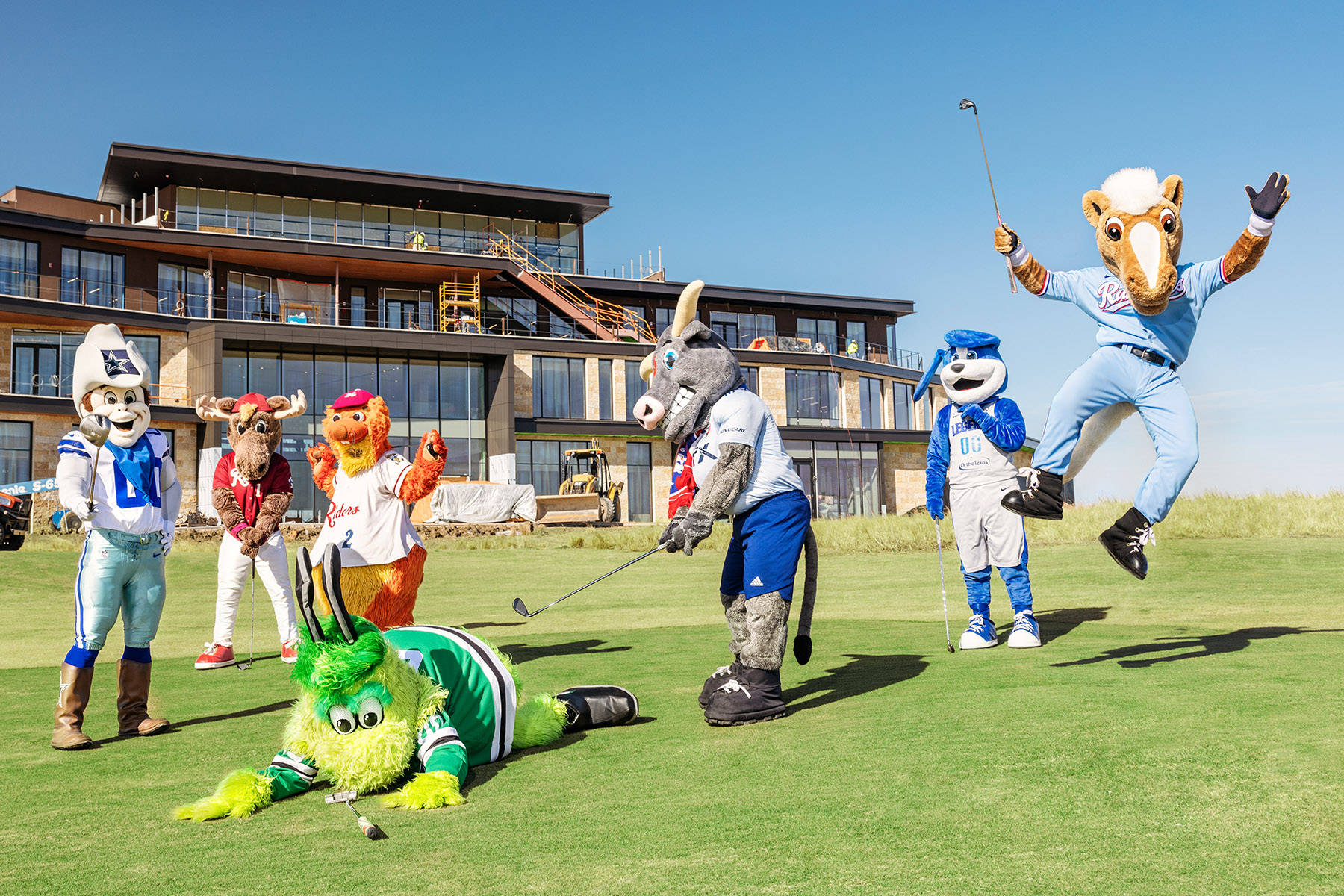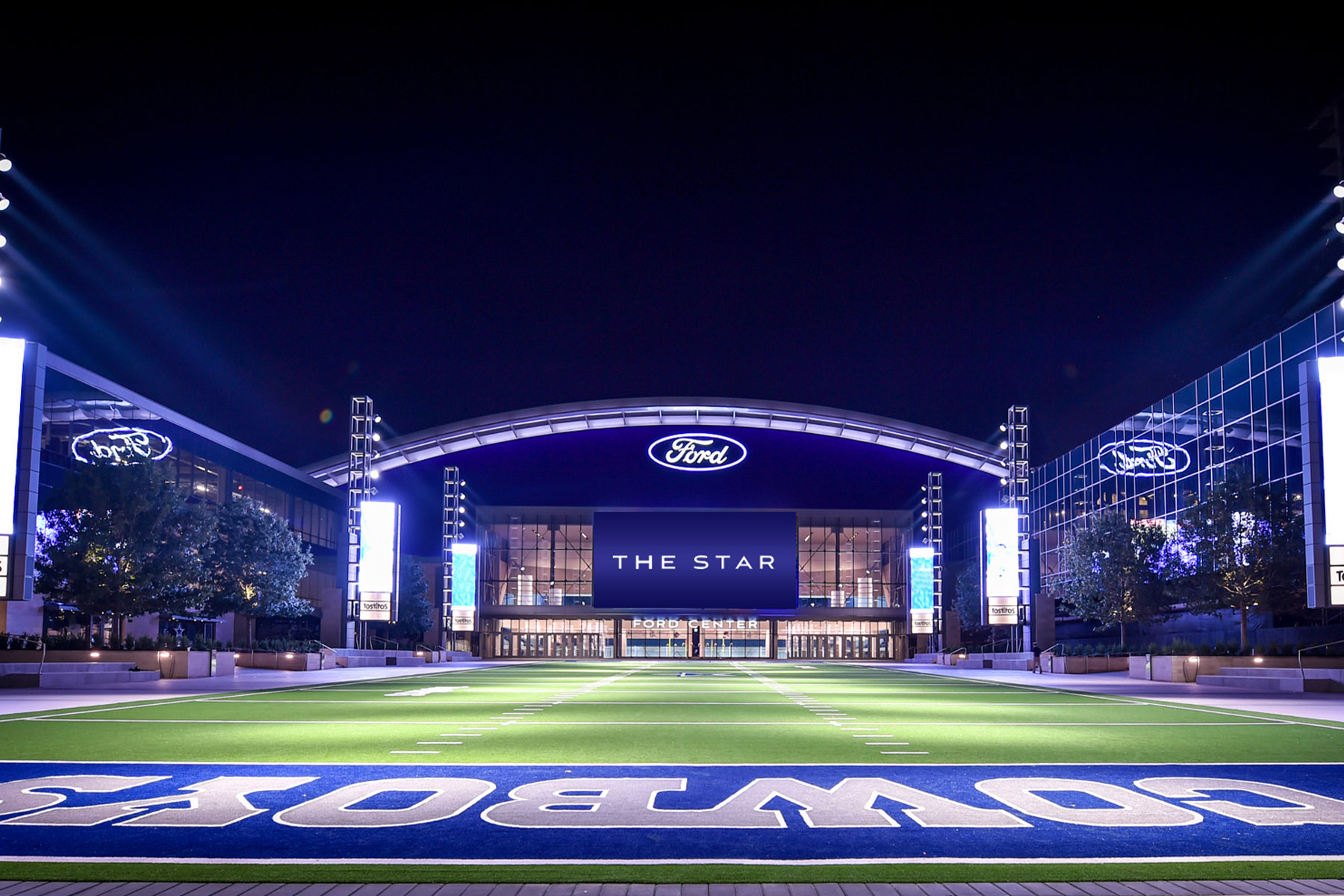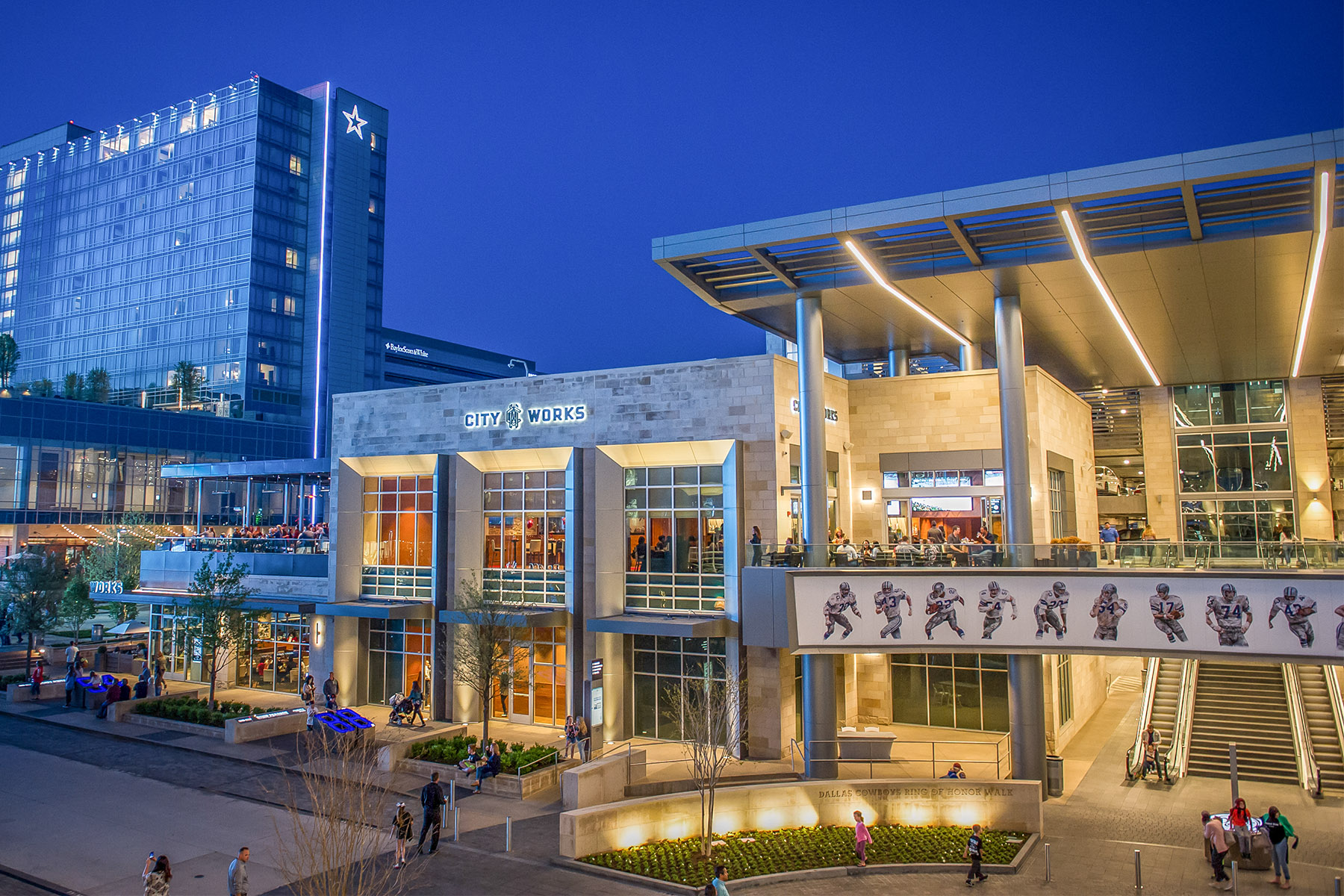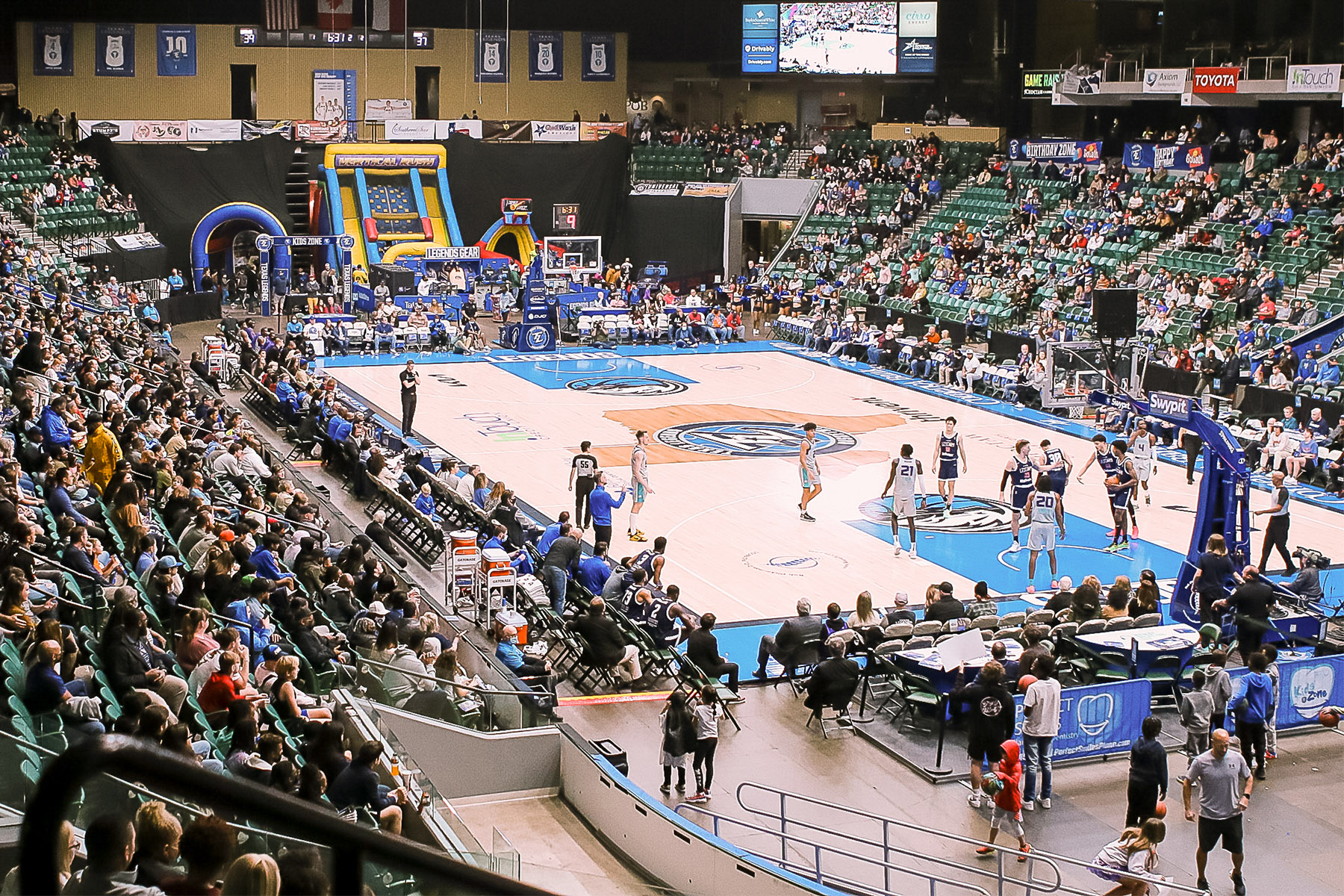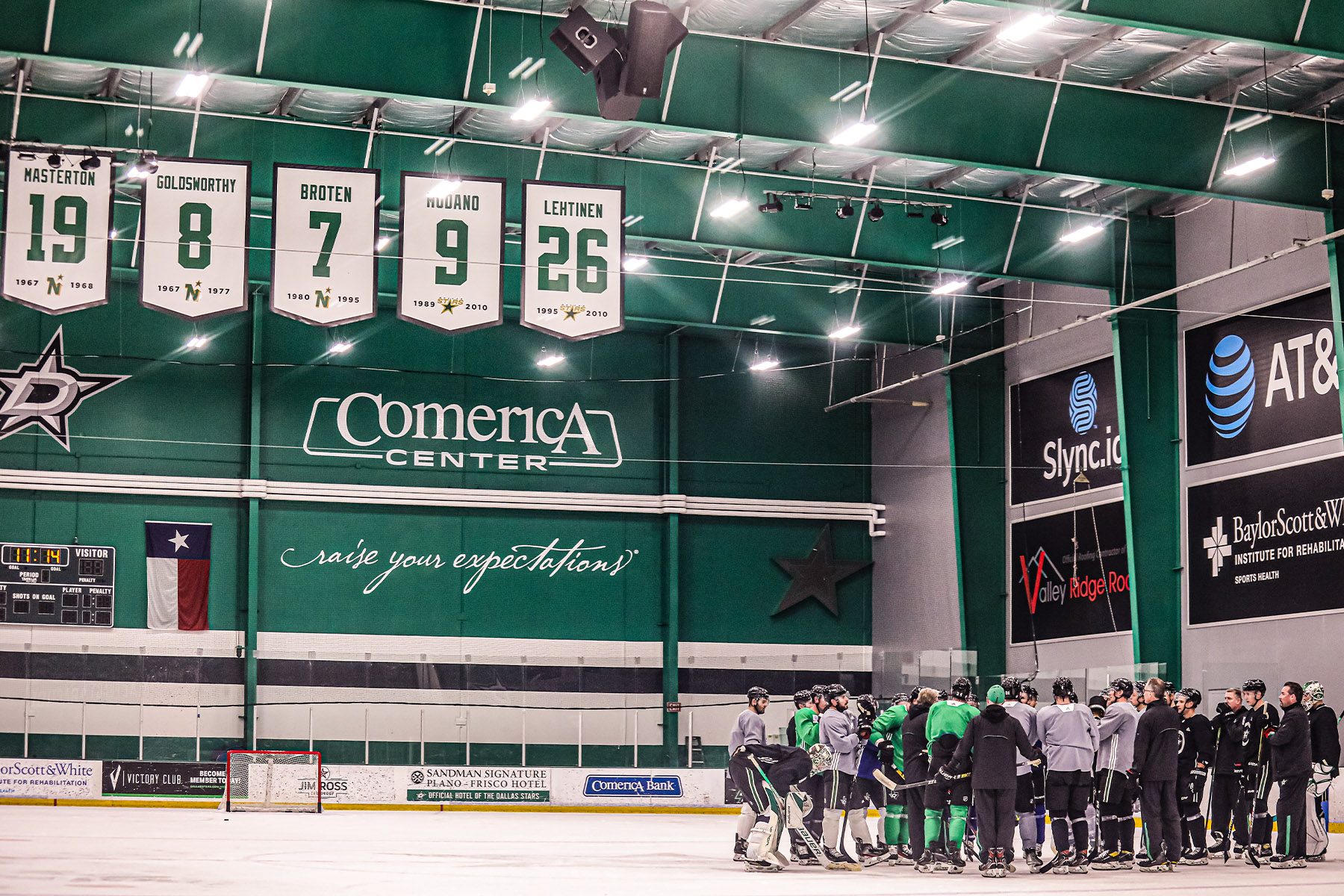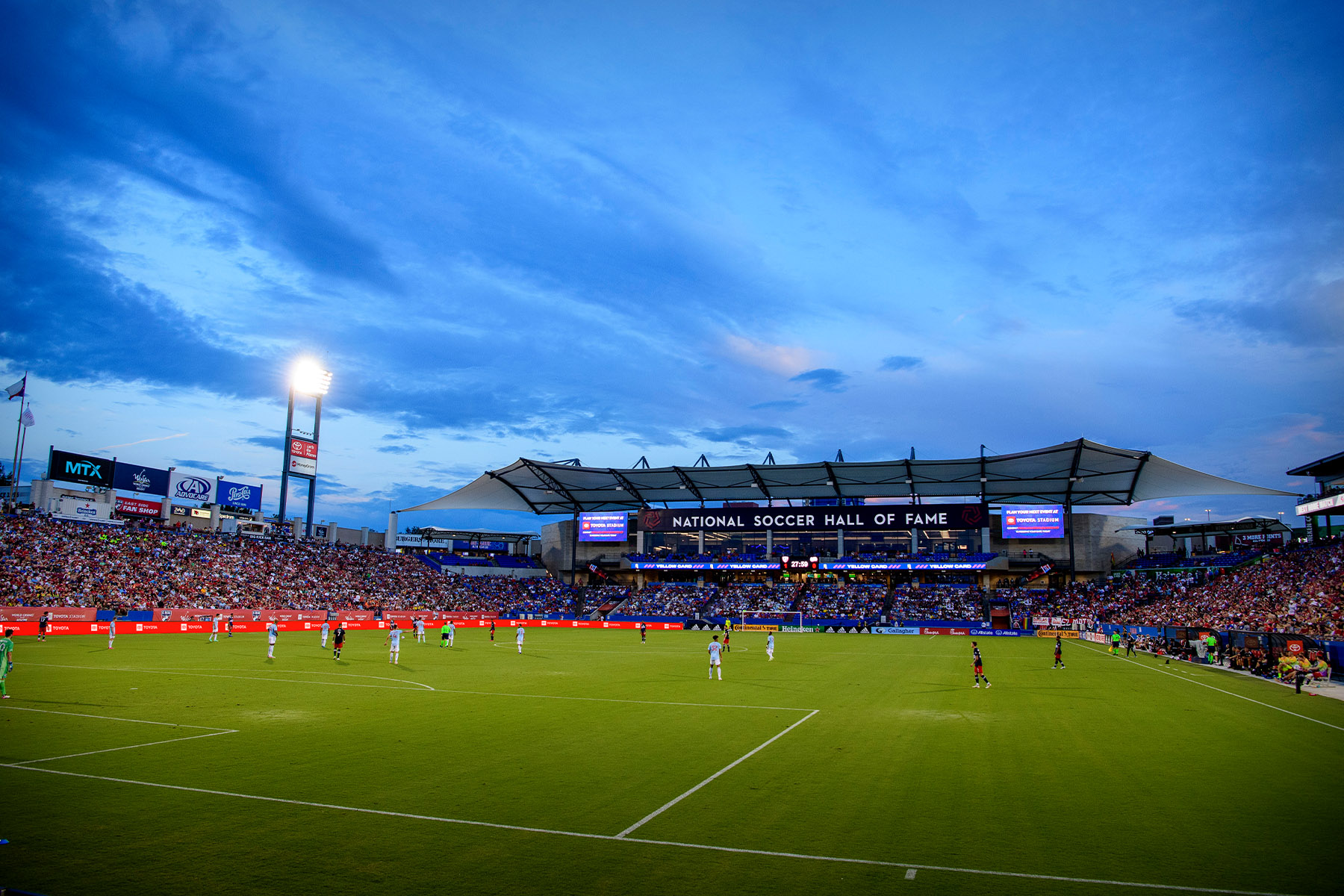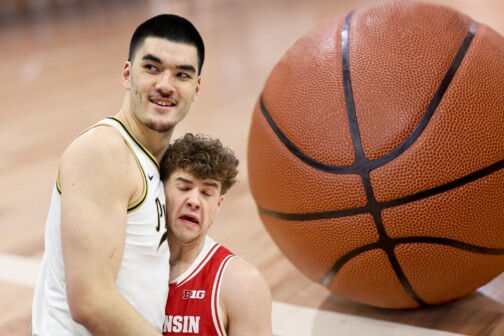Stephen Jones saw gold in the hay fields. It was 2013, and the Dallas Cowboys’ CEO recognized that his team had outgrown Valley Ranch, the Irving headquarters and practice facility it had called home since 1985. The locker room was cramped, the weight room outdated. There was no indoor field, which meant that on cold or rainy days, the most valuable sports franchise on earth had to trek north to conduct practice at Coppell High School.
A real estate broker named Rex Glendenning approached the organization on behalf of the city of Frisco. A deal to build a Nebraska Furniture Mart had fallen through, and a 91-acre parcel of land had become available. Jones knew the area well. His family had been doing business in Frisco for the better part of two decades, ever since his father had purchased a huge subdivision called Starwood, in 1994, through their Blue Star Land real estate company. They kept on gobbling up land around the Dallas North Tollway, going past Highway 380, to keep pace with a development trend that Jones believes will one day reach the Oklahoma border. Those 91 acres of hay just off the Tollway represented more than a business opportunity; they were a lifeline.
Jones thought, “We could have a foothold over here and communicate and have something that people can touch and feel and, hopefully, convert people from other cities to be Cowboys fans.”
Five years later, The Star celebrated its grand opening with four days of concerts and family activities—pomp and circumstance befitting a development that has changed professional sports. Jones admits that the team “didn’t necessarily have a vision in mind of a practice facility as a way to be the centerpiece of something that was economically so viable,” but that’s exactly what happened. The Star is an entertainment district, a corporate headquarters, a year-round multipurpose sports site, a sports medicine laboratory, and a tourist destination. It showed how teams can leverage their brands to become real estate developers.
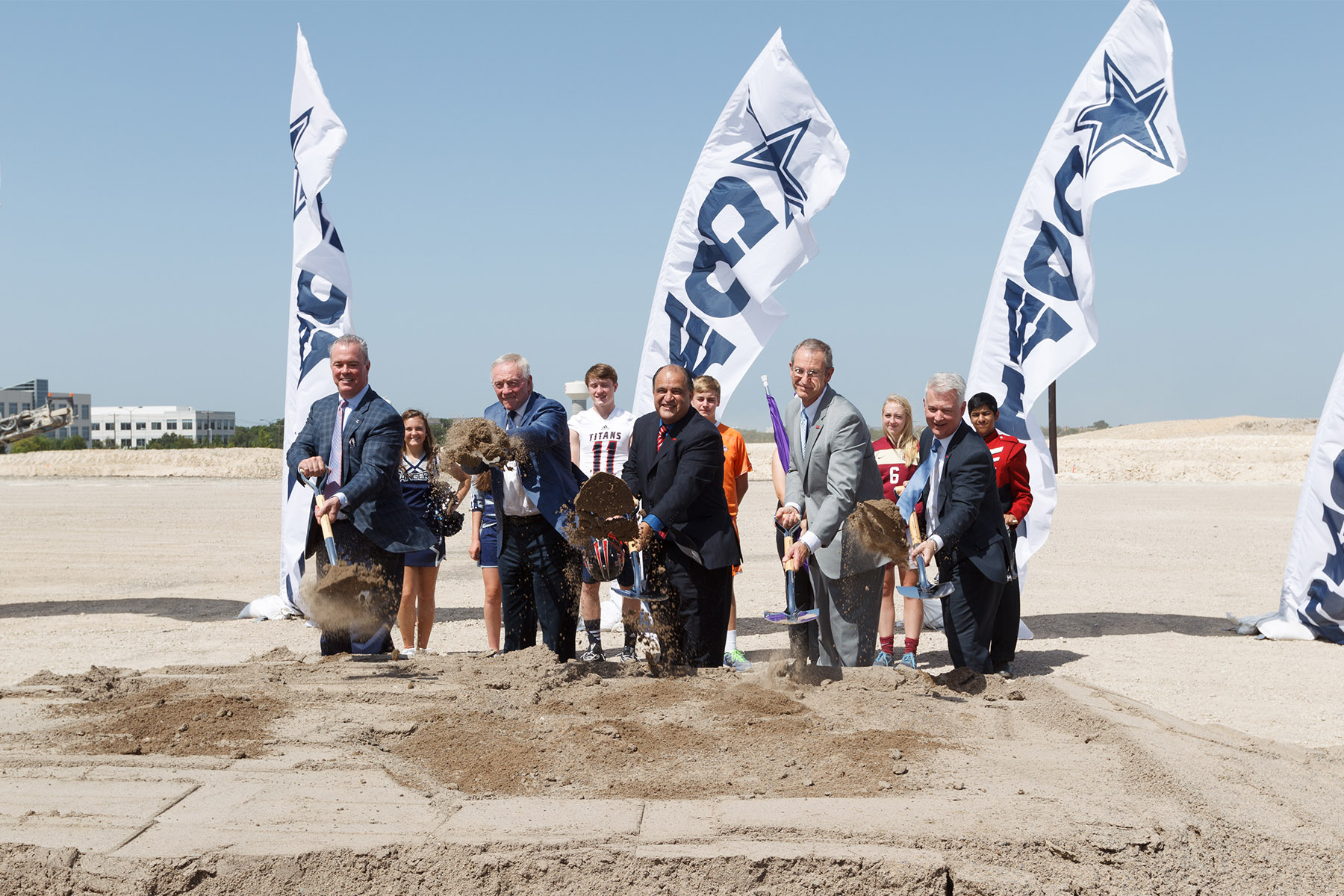
For years, Frisco had billed itself as Sports City USA, a byproduct of being home to the Dallas Stars’ corporate headquarters and practice facility, minor league affiliates of both the Dallas Mavericks and Texas Rangers, and FC Dallas’ entire operation. But, as Dallas Stars President Brad Alberts says, “When the Cowboys announced The Star and then actually started breaking ground and building it, and everyone knew what that was going to be, that certainly changed the trajectory and has led to you going, ‘Wow, this is a whole different area.’ ”
No other city of Frisco’s size is based in a top-five media market and is involved with all of the country’s five largest professional sports leagues, to say nothing of hosting the NCAA Division I Football Championship Subdivision (FCS) national championship game, an additional college football bowl game (the Tropical Smoothie Cafe Frisco Bowl), one of the country’s premier esports teams (Complexity), or the constant stream of youth sports. Up next is the PGA of America, which has built two 18-hole golf courses and is relocating its headquarters from Florida to create an enormous mixed-use development that includes a hotel and convention center.
“Sports City USA” has become more than a marketing moniker. Frisco seized on a novel financing strategy to fuel a professional sports boom that helped drive and sustain a population explosion. It truly is a unique American experiment. And it all started with a God-fearing city manager who wasn’t afraid to make a big bet.
George Purefoy said his prayers. 1987 marked his seventh year as the city manager of Columbus, Texas, a town of about 3,900 people located 75 miles west of Houston. The job suited him, at least better than his prior career as a police officer in Arlington. But the savings-and-loan crisis had hit South Texas hard, and Columbus had gone stagnant. “We probably built 30 to 40 homes in those seven years,” he says. It was also far from his hometown of Mineral Wells, where his parents were growing older. He and his wife, Debra, were ready for a change.
So he pulled up a map of North Texas and looked for a city with growth potential. He traced his finger up the Dallas North Tollway and saw Frisco, then about the same size as Columbus. Purefoy had barely heard of the place, much less visited, but he figured its location was propitious. And the city had set itself up for geographic growth by annexing a narrow strip of land that effectively cordoned off a large area, protecting it from other hungry suburbs. (The state Legislature would prohibit the “strip annexation” gambit in 1999.) As Purefoy tells it, he and Debra prayed that night “that God would lead us to a city in the Metroplex that had growth potential.” A week later, he received a letter from Frisco inviting him to apply to become its first city manager.
He arrived in November and soon discovered that his new home had its own issues. North Texas hadn’t escaped the S&L crisis, and Frisco’s resources were stretched thin. His “welcome to town” moment came on his second day on the job, when a mansion used for filming early episodes of Dallas burned down because there were no fire hydrants on the property. Still, the city had a pair of promising subdivisions in development as well as a new jetport on the west side of town. The 30 to 40 houses he had built in seven years in Columbus became more like 30 to 40 annually in Frisco.
“So, by comparison, this thing was on fire,” he says with a chuckle. He is seated at a conference table in his office on the fifth floor of Frisco’s George A. Purefoy Municipal Center, an honor that, in all likelihood, mortifies him. Purefoy is a reserved man prone to soft speech and long pauses. He prefers to seal deals with a handshake and is loath to take credit for them.
“His strength is his faith, his ethics, his integrity,” says Maher Maso, a city councilman from 2000 through 2007 and a three-term mayor from 2008 through 2017. “I hear those words a lot. I’ve never really seen anyone at his level be able to maintain all that without any changes.”
The building name is deserved. Mayors have come and gone, the City Council has turned over many times, but Purefoy has been the constant, the person most responsible for elevating Frisco from backwater to boomtown. When he retires in June, he will have spent 35 years in his role—an eternity for any position but especially this one, which Maso likens to a CEO building a startup and then adapting his talents as it becomes a mega-corporation. In Purefoy’s tenure, Frisco’s population has jumped by a factor of 50 while the city budget has swelled from $1.8 million to $746 million.
“The best way to explain it is, if you make believe that the city of Frisco is his daughter, you will see how he treats it,” Maso says.
Purefoy didn’t intend to turn Frisco into a sports juggernaut. The goal was tourism, in whatever form it took, to help the city avoid becoming a bedroom community. It just so happened that sports are not only a proven draw but a family-friendly one, which jibed with the image Frisco hoped to cultivate for itself. Purefoy and the City Council’s first target was minor league baseball. The idea came up in 1996, yet it would take years to gain traction outside the City Hall. “More than likely because we were kind of out in the middle of nowhere,” Purefoy says. That changed in 2000 with the opening of Stonebriar Centre, the city’s first major development north of Sam Rayburn Tollway. The retail behemoth, Purefoy says, “really flipped the switch. I think most of us point to that as kind of saying that it sent signals to the developers and commercial community that Frisco’s for real.”
The following year, Purefoy brokered a deal with Hicks Sports Group, then owner of both the Rangers and the Stars, to build a minor league ballpark that would house the Frisco RoughRiders, the Rangers’ new Double-A affiliate, along with a headquarters and practice facility for the hockey team. Next came soccer, in 2003, after Purefoy shook hands with Lamar Hunt on an agreement to build a stadium for FC Dallas, then playing in the Cotton Bowl as the Dallas Burn, after Hunt’s initial deal with McKinney had fallen apart. Included in the agreement was the complex that would establish Frisco as a youth sports hub: 17 stadium-quality, regulation-size fields that, according to FC Dallas, attracted more than 1 million people annually to Toyota Stadium in a typical pre-pandemic year.
In 1987, George Purefoy and his wife prayed that God would lead them to a city with growth potential. A week later, Frisco invited him to apply to become its first city manager.
By 2009, less than a decade after no sports team took them seriously, the city was so entrenched in the space that Donnie Nelson, then president and general manager of the Dallas Mavericks (and a longtime Frisco resident), bought a Colorado-based team in the G League, the NBA’s developmental affiliate, with the express purpose of moving it to town. Purefoy characterizes Nelson as “aggressive” in his pitch, which fits the pattern of deals Frisco now makes in sports. They wait for the market to come to them, and once it does, the city follows a process so familiar that the deal to build The Star took all of a couple months to get City Council approval. (Maso says they spent the bulk of that time trying to figure out if they could lay a track around the field at the Ford Center, The Star’s 12,000-seat indoor football stadium.)
Sports are now an integral part of the Frisco story, bringing in millions in revenue and thousands of jobs and transforming the city so thoroughly that there’s no imagining life without them. Maso guesses something else would have bubbled up for entertainment—a music festival, perhaps, or maybe a theme park. But it’s a safe bet that nothing else would provide this kind of “larger wingspan,” as Purefoy puts it, and the bulk of the credit goes to him. Given all that, maybe a building named after him doesn’t go far enough. Seth Waugh, CEO of the PGA of America, proposes a statue. Better yet, he says, “They should build 12.”
Rick Reedy had never encountered an idea so big. By 1997, he had worked in the Frisco Independent School District for 21 years, going from a girls’ sports coach all the way to superintendent. The city had always maintained a cordial relationship with the school district. But the two organizations had never collaborated on a scale like Purefoy suggested, which is why it would take Reedy months to get the school board to fully appreciate what was on the table and how it would change the fortunes of both the district and city.
The concept was called a Tax Increment Reinvestment Zone—TIRZ for short. In a nutshell, it’s a way for a city to spur development by using future property tax growth to feed that same development. Frisco had no shortage of land to develop in the late 1990s, which is why, when Purefoy drew up a TIRZ with Stonebriar in mind, he made the zone 713 acres. That stretched well beyond what the mall would ever require, but who knew what else Frisco might attract in time? And he wanted Frisco ISD to be part of the deal.
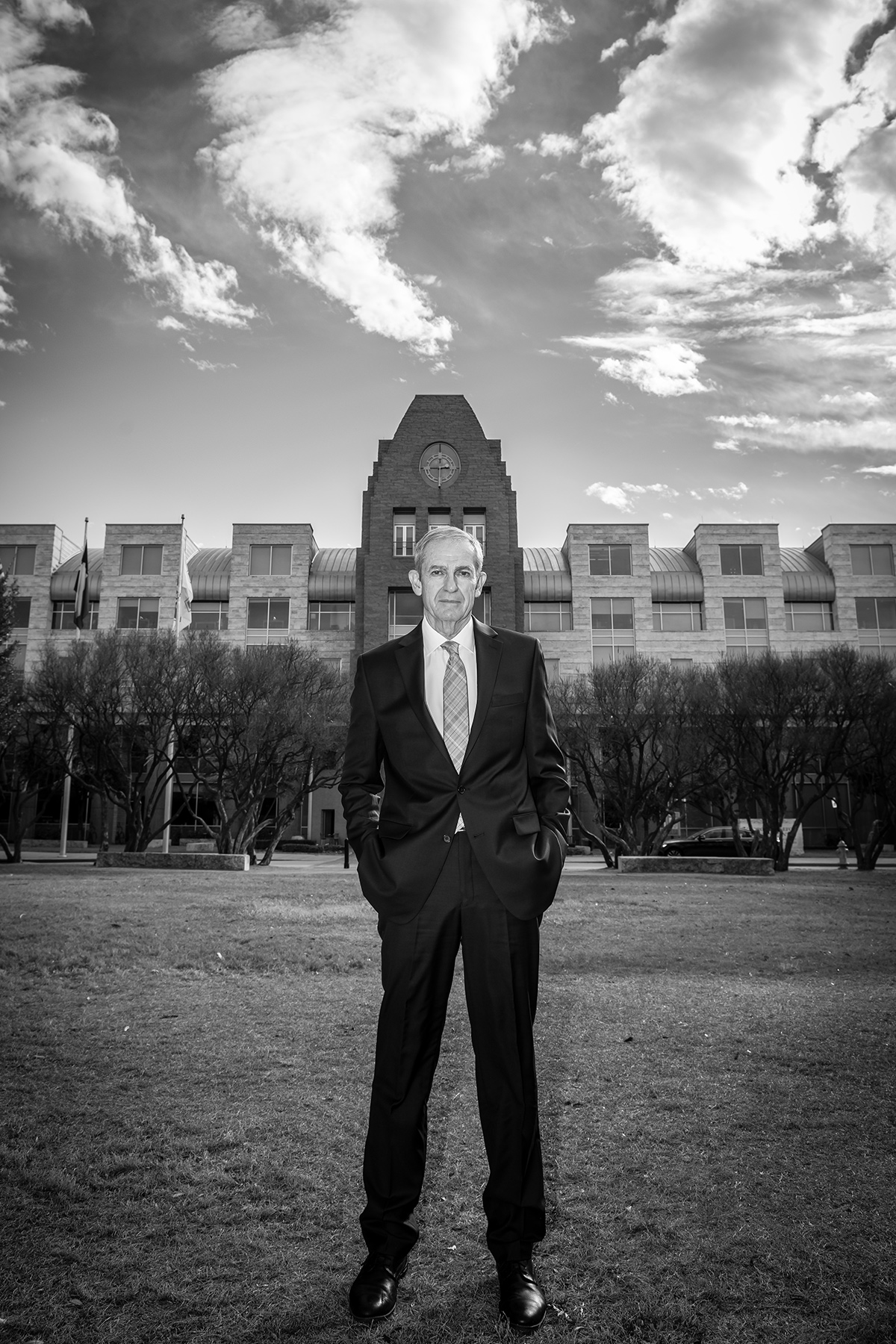
A lot of factors have driven Frisco’s explosive growth and rise as a sports powerhouse. But the most unusual—and most important—is that a school district helps broker billion-dollar deals with professional sports entities.
“Basically, they’ve been our partner in every one of these facilities,” Purefoy says. While they are not the only outside partner the city engages, cutting the school district into deals brings added financial muscle to the table, softening the burden on the city and the sports entities it’s trying to attract. Frisco ISD has contributed $84.8 million to sports projects since the TIRZ was established, $30 million of which is ticketed to The Star over 25 years.
In turn, provisions are carved into each deal that give the school district access to the facilities. Frisco ISD athletes play football each Friday night at Ford Field at The Star. Same goes for soccer at Toyota Stadium. They play the occasional baseball game at Riders Field, and when the PGA of America is ready later this year, 150 kids will practice on-site, and Frisco ISD will host the district championship on the PGA’s courses. When May rolls around, the school district uses Ford Field and the Stars’ Comerica Center as sites for graduation ceremonies. They’ve even enhanced the curriculum by way of the school’s Independent Study & Mentorship program, which allows upperclassmen to research and shadow professionals in different fields. That can mean learning sports medicine at Baylor Scott & White Sports Therapy & Research at The Star. More fields of study will be tied to the new PGA of America development. And on Friday nights, students get to operate NFL-quality video and audio equipment at Ford Field.
Frisco ISD could have followed the lead of McKinney and Allen and constructed a landmark football stadium, taking on bond debt to front tens of millions of dollars for construction before assuming hundreds of thousands in annual maintenance costs. Instead, the city and its development partners own and operate the facilities, giving Frisco ISD a wider footprint with less overhead. It’s the municipal equivalent of subscribing to Netflix instead of buying a Blu-ray collection.
“You’ve got probably close to $400 million worth of facilities that they’ve got use of when they need versus one $60 million [facility],” Purefoy says.
But the greatest benefit, both to the city and the school district, comes on the back end. Two decades of ongoing development in the TIRZ have built up a tax base that keeps feeding the economic engine. That $30 million Frisco ISD poured into The Star? “You can pencil out the numbers over the next 30 years, and we will generate more revenue from the structures around that stadium than what we’ll pay out in the stadium,” says Todd Fouche, the district’s deputy superintendent for business and operations.
The school district is constrained in what it can do with its share of the money flowing from the TIRZ. It can’t, for instance, be allocated to day-to-day operating expenses, such as salaries or maintenance. It can, however, be directed to pay off bond debt on buildings, a boon for a district that estimates it has opened an average of three new schools per year for the past two decades. That financial safety net is essential as Frisco’s population continues to surge—and, with it, demand for public education.
Frisco has created a self-sustaining loop. The more tax revenue sports generate, the higher the TIRZ payout. The higher the TIRZ payout, the more Frisco ISD can afford to expand while keeping taxes low. And as the district expands, so does the need to accommodate student athletes, which emboldens the district to keep investing in sports-oriented development (and help keep existing facilities humming by funneling in more youth sports). This feedback loop will continue to elevate Frisco’s profile.
Texas is the only state in the country with TIRZ provisions, and while there are more than 200 zones scattered across the state, Frisco’s is one of only about 20 that have a school district as a partner. Frisco’s TIRZ removes part of the school district’s property wealth from the Robin Hood formula that the state uses to distribute money from wealthy districts to poorer ones. As a result, Frisco ISD gets to keep an outsize portion of tax revenue generated there. In 1999, the state Legislature grandfathered Frisco and the 20 into the arrangement and then killed it for everyone else.
Seth Waugh needed a new place to change the sport of golf. 2016 marked the PGA of America’s 51st year in its home at Palm Beach Gardens, Florida, and the association wanted a refresh. So Waugh, then a PGA board member, was tapped to find a new headquarters. He spent a year sending RFPs to cities such as Charlotte, Phoenix, San Diego, Nashville, Atlanta. “All the places you’d imagine are golf-y places,” he says. After he was appointed CEO, in 2018, he had to make a decision. By then he had whittled his options to two. One was to build a new facility in Palm Beach Gardens. The other—“the one that jumped out”—was Frisco.
The PGA broke ground in a sports city different from the one in which the Stars and Rangers had planted their flags, or the one the Mavericks and FC Dallas had solidified as a market force, or the one the Cowboys had elevated into the national conversation. What was once the middle of nowhere is now an epicenter. As Nelson puts it, “Folks from Frisco, they really don’t want to get on the toll road with the way the population explosion has happened and drive down [to Dallas].”
The PGA’s gargantuan $520 million, 660-acre multi-use development near the city’s northern boundary is Frisco’s biggest sports deal yet. By the second quarter this year, the bulk of the association’s employees will have relocated to the new headquarters. In 2023, an Omni resort featuring 501 rooms and a destination spa will open its doors. So will two championship courses plus a 75,000-square-foot putting course. The following year, a retail and entertainment center will go operational. And in 2027, the PGA Championship, one of golf’s four major tournaments, will be contested in Frisco. The aim, Waugh says, is to make Frisco the Silicon Valley of golf, the place where the sport is presented at every level to every demographic at every level of interest.
“There is no reason for any golf fan to visit our headquarters in Palm Beach,” Waugh says. “But there are a lot of reasons for them to come to the PGA in Frisco.”

The PGA won’t be the last development in Frisco. Sports City USA will keep expanding, and its current occupants wouldn’t have it any other way. They’re used to year-round competition elsewhere in North Texas, but they’re also accustomed to collaboration, too. The Hunt family, which still owns FC Dallas after Lamar’s death in 2006, has known the Joneses for decades. Their two organizations are working together on Dallas’ bid to host World Cup matches in 2026. The Stars and Mavericks were co-tenants at the American Airlines Center well before they began cohabitating at the Comerica Center in Frisco. The Cowboys and Rangers are neighbors in Arlington, and the Rangers and Stars have a shared history from their days under Tom Hicks’ umbrella. All of them have made money for generations throughout North Texas. Why should it be any different in Frisco?
“It’s the ‘gas station on four corners’ argument,” Nelson says. “We’ve all got our place. Everyone is doing great. There’s no one starving at the table, and anything that’s good for Frisco, we’re all over. Look, there’s plenty of entertainment dollars to go around. There’s tons of corporate infrastructure. The sandbox is getting richer, not poorer.”
The city’s next task is to keep it that way. As much as sports have shaped Frisco’s growth, Purefoy believes their greatest value might come through sustaining it. He has seen suburbs come and go in his five decades in government, most of them like shooting stars: quick to rise, quicker to burn out. Frisco’s ascent broke the mold, and he wants the same to hold true now that it’s on top. “We don’t think that sports is the answer, but we think it may be part of the answer and helps keep it vibrant, keep it young, bring some vitality to the community,” Purefoy says.
No one, not even Purefoy, presumed Frisco could become what it has, as a sports town or a city at large. The PGA’s Waugh says, “The magic of Frisco is kind of like, OK, we’ll build a highway to nowhere, and then we’ll put in a practice football facility, and we’ll add water, and all sudden we’ll be the fastest-growing city in the country.”
It sounds implausible. But that’s exactly what happened.
Get the ItList Newsletter
Author



